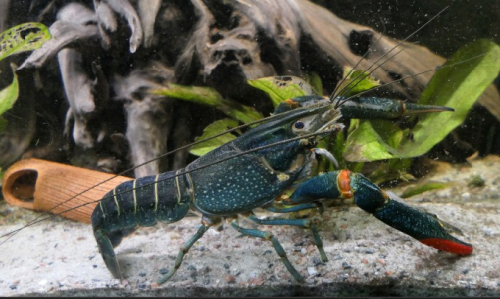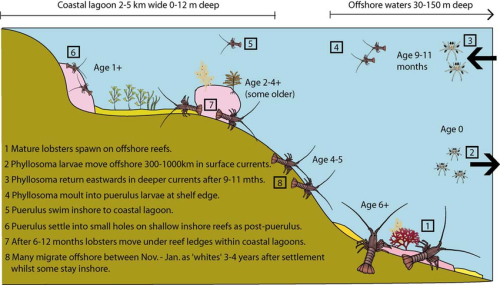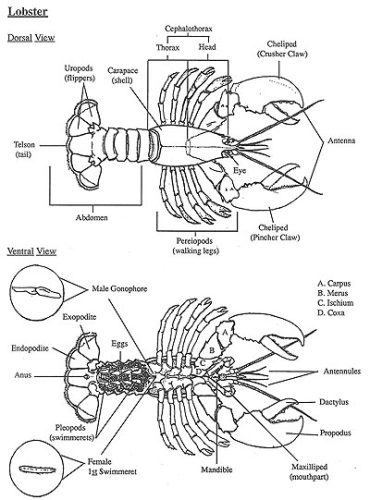Lobster: Between Economic Value and Ecosystem Sustainability

Freshly caught lobster (Photo Credit : Bryan Snyder)
Indonesia is blessed with abundant biodiversity, including various types of aquatic organisms that live in both freshwater and marine ecosystems, one of which is the lobster. Generally, lobsters are known as large shrimp that live in coral reefs, but there are also freshwater lobsters from the genus Cherax, originating from Australia, Papua New Guinea, and Irian Jaya, with various species. One of the most economically valuable species is Cherax quadricarinatus (red claw). Cherax inhabits shallow freshwater environments with muddy substrates and plenty of crevices and cavities for hiding. This species is relatively easy to cultivate, with high environmental tolerance and relatively few disease issues. Unfortunately, the development of Cherax farming activities is still very limited.

Red claw crayfish (Photo Credit : Wikimedia Commons)
Lobsters, also known as rock shrimp or barong shrimp, belong to the genus Panulirus in animal classification. Their life cycle consists of five phases: naupliosoma, phyllosoma, puerulus (post-larva), juvenile (young lobster), and adult lobster.

Panulirus cygnus life cycle (Photo Credit : Glenn A Hyndes)
Morphologically, lobsters have segmented bodies, similar to other shrimp. The lobster’s body is divided into two main parts: the head, called the cephalothorax, and the body, called the abdomen. The body is segmented and equipped with five pairs of swimming legs and a fan-shaped tail fin. These characteristics distinguish lobsters from other types of shrimp.

Lobster morphology (Photo Credit : Department of Marine Resources, State of Maine)
In 100 grams of lobster, there are 88 calories and the following nutrients:
- 19 grams of protein
- 0.9 grams of fat
- 160 milligrams of potassium
- 129 milligrams of phosphorus
- 91 milligrams of calcium
- 80 milligrams of choline
- 73 milligrams of selenium
- 36 milligrams of magnesium
- 4 milligrams of zinc
- 145 milligrams of cholesterol
In addition, lobster is a source of omega-3, copper, vitamin B3, vitamin B6, and folate. However, like other seafood, lobsters are high in sodium. In 100 grams of lobster, there is about 665 milligrams of sodium, which accounts for a third of the recommended maximum daily salt intake.
Compounds in lobster offer various health benefits, including boosting immunity, maintaining bone health, and improving brain function due to the omega-3, DHA, EPA, and selenium content, which may also reduce cancer risk. Additionally, the minerals zinc and magnesium help maintain thyroid gland function.
Marine lobsters (Panulirus spp.) are nocturnal species that live in coral reef habitats. The increasing market demand for this commodity has encouraged fishermen to catch more from the sea. Since this commodity still heavily relies on the ocean, it is crucial to protect ecosystem sustainability, especially coral reefs, which are the primary habitat for Panulirus spp..
By 2030, the economic value of Indonesian lobster farming is projected to reach USD 53.86 billion. The largest lobster-producing regions in Indonesia include Gresik, Cilacap, Aceh, Yogyakarta, Lombok, Pacitan, and Sukabumi. The enactment of KP Regulation 7/2024 on the Management of Lobster (Panulirus spp.), Crab (Scylla spp.), and Blue Crab (Portunus spp.) in the Territory of the Republic of Indonesia introduces a new policy on reopening the export of baby lobsters (BBL), which is feared to facilitate the exploitation of lobsters and their juveniles in the wild. Several cases of baby lobster smuggling in regions like Banten and Batam, valued at billions of rupiah, show the consequences of this policy. The Ministry of Marine Affairs and Fisheries has announced the development of an electronic monitoring information system to oversee the utilization of baby lobster capture quotas by fishermen or fishing groups. This system is expected to prevent uncontrolled exploitation of lobsters and their juveniles.
There is a need for increased awareness among fishermen and seafood consumers, especially lobster enthusiasts, to avoid catching or consuming large, egg-bearing lobsters. If caught, these lobsters should be released to allow them to reproduce, thereby maintaining the sustainability of the ecosystem.
-YN

